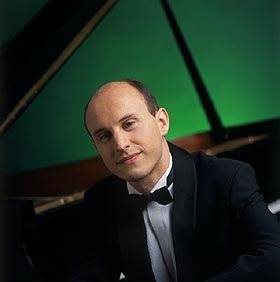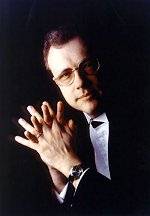S & H Recital Review
Pianists at Wigmore Hall, Nelson Goerner and Marc-André Hamelin (pfs), Wigmore Hall, June 2003 (MB)
One of the glories of the Wigmore Hall is its Monday lunchtime recital and the past two have been devoted to the pianists Nelson Goerner and Marc-André Hamelin. Both are very different kinds of pianist and both offered very different kinds of programme – yet in both cases the results were superb.
Nelson Goerner shares with Daniel Barenboim both Argentinian nationality and a parallel sense of introspection; Goerner’s Schubert, for example, is emboldened by a muscularity of tone, as Barenboim’s was in his early years, and a super-refined keyboard touch that speaks often with the conflict of inner sounds (this is a pianist who knows exactly how to play a pianissimo marking in the context of the wider dynamic picture). In the D850, for example, Goerner bought an intensely prophetic voice to the Con moto, which at times sounded almost improvised, but the rhythmic syncopations and impressionistic colouring which litter the second theme were masterfully negotiated with kaleidoscopic brilliance. A similar delicacy illuminated a spontaneous reading of the Rondo. Yet, things were not always as crystalline as this. Goerner is, to put it politely, a diminutive figure (when he appeared on the platform he seemed quite overshadowed by the Steinway) but he seems almost to overcompensate for this by producing fffs of massive proportions. It is arguable that his performance of the opening Allegro vivace was just too loud with the consequent muddying of textures and dynamics such rampant playing might suggest. Yet, even here, there were compensations – his pedalling, for example, is a revelation that seems to control his sometimes heavy keyboard range.If such a technique is not ideally suited to the subtleties of Schubert’s late sonatas it did not seem misplaced in a stunning performance of Liszt’s Mephisto Waltz No 1. After recently hearing Kissin perform the same work (in a recital of the same composers) Goerner’s performance is one that doesn’t find itself overshadowed by Kissin’s own forbidding technique. The interpretation was devilish with Goerner overplaying the dissonance of the piled-up fifths just enough to suggest the Mephistophelian allusions. With the waltz delivered with expressive range and the gallop driven by an apocalyptic rush of horsemen on the brink it was a performance that melded the seductive with the virtuosic. Goerner’s tremendous forte playing (which reminded me of Toscanini’s quip that if he got his orchestra to play any louder he’d break the recording equipment – ‘Break the equipment!’) merely added to the drama. His Proms debut this year – in Prokofiev’s Third Piano Concerto – should be an unmissable concert based on this recital.
Marc-André Hamelin’s recital was of a very different kind. Eschewing the gravity of Schubert and the blistering virtuosity of Liszt Hamelin chose Schumann and Albéniz. In some ways this recital was at an altogether higher level of artistry than Goerner’s had been; yet, Hamelin’s intellectual grasp, incandescent keyboard control and near-perfect tonal range (especially evident in Iberia) didn’t always overshadow Goerner’s own achievements.Schumann’s Fantasiestücke Op.12 suffered at times from a loudness that mitigated some of this work’s delicacy. True, the opening bars of ‘Die Abend’ had been delivered with a clear separation of the right and left hand variant that seemed at first hypnotic but it was also somewhat anodyne, not helped by some splintered note playing that coarsened the mood. ‘Aufschwung’ ended with an abrupt closing pedal that made this reviewer too well aware of the problems with balance Hamelin seemed to be having early on in the work. This settled quickly – and for the next six movements Hamelin gave us a performance that was as well defined as you could expect to hear. Brilliant articulation – especially in ‘Traumes-Wirren’ - struck the ideal balance between virtuosity and poetry and in ‘In Der Nacht’ there was a titanic struggle that ended in almost unresolved anger, aided by some spectacular sonorities of shattering proportions. Contrasted with the brooding introspection of ‘Ende vom Lied’, with the resolution of the coda so beautifully counterpointed, it was a performance that developed into something memorable.
Even more so was Book 3 of Iberia, this performance of which dripped with Mediterranean colour. Notable was the closing ‘Lavapiés’ – in part of a riot of conflicting harmonies and decorous tonality - which was incandescently played and poetically conceived. ‘El Polo’ had been a raucous display of obsession and collision with Hamelin evoking from the keyboard a glittering array of effects suggestive of the strumming percussiveness of the guitar. ‘El Albaicin’ had the perfect balance of tranquillity and sultry perfume. It impressed on simple terms – and not least because Hamelin showed how intensely full of colour and impressionistic the piano can sound.
Marc Bridle
Lunchtime recitals on a Monday continue at the Wigmore Hall until 14th July 2003. They begin at 1pm and are broadcast live on BBC Radio 3. A repeat broadcast is at 1pm each following Sunday.


 Return to:
Return to: